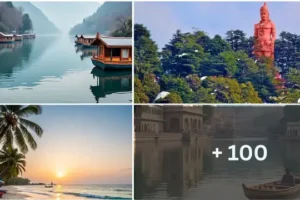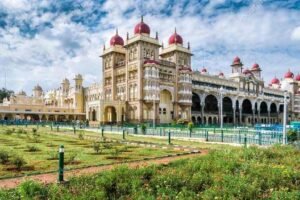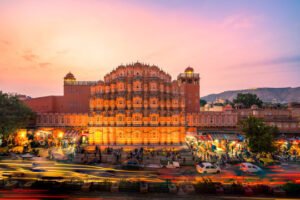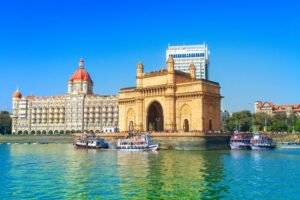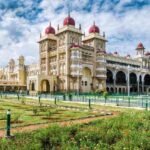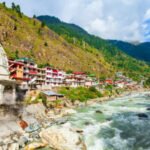The Mystique of Baglamukhi Temple, How to Reach, Best Places to visit Nearby
Introduction to Baglamukhi Temple: Nestled in the serene environs of Bankhandi in the Kangra district of Himachal Pradesh, the Baglamukhi Temple stands as a monumental edifice of profound spiritual significance. Renowned across the region and beyond, this temple is dedicated to Goddess Baglamukhi, one of the ten Mahavidyas (great wisdom goddesses) in Hindu mythology. The temple exudes an aura of mystique, drawing countless devotees and spiritual seekers who are enticed by its powerful ambiance and historical eminence.
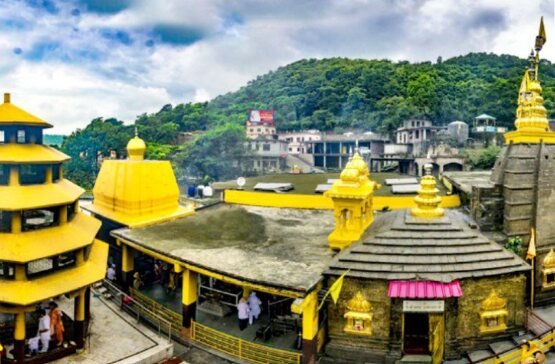
The origins of Baglamukhi Temple trace back to ancient times, with legends suggesting its establishment during the Dwapara Yuga. It is believed that the temple was consecrated to honor Goddess Baglamukhi’s victory over evil forces, thereby positioning her as a symbol of power and protection. Historically, the temple has seen numerous patrons, including kings and sages, who have contributed to its maintenance and reverence, thus preserving its antiquity through the ages.
The historical significance of the Baglamukhi Temple is amplified by its deep-rooted connection to local culture and spirituality. For the residents of Bankhandi and the wider Kangra district, the temple is not just a place of worship but also a pivotal center of cultural identity. The festivals and rituals conducted here are intrinsic to the region’s spiritual calendar, with ceremonies drawing large congregations of people who come to pay homage and seek blessings.
Moreover, the temple is surrounded by scenic natural beauty, enhancing its allure as a tranquil retreat for meditation and reflection. Visitors are often captivated by the temple’s architecture, which resonates with classic Himachali style, adorned with intricate carvings and vibrant frescoes that narrate tales from Hindu scriptures. Thus, the Baglamukhi Temple in Bankhandi is not only a beacon of spiritual devotion but also a testament to the rich cultural heritage of Himachal Pradesh.
The temple, believed to have been established in ancient times, has been mentioned in various Puranas and Tantric scriptures that detail rituals and the power of Goddess Baglamukhi. The Skanda Purana, in particular, highlights the temple’s profound spiritual significance, reiterating its sanctified status. Over the centuries, the temple has witnessed numerous renovations and reconstructions, preserving its grandeur and spiritual essence intact. Historical records suggest that the temple has stood witness to several significant events, including its association with various kings and local rulers who contributed to its development and upkeep.
In the medieval period, the temple’s prominence soared, becoming a vital center for Tantric practices. Devotees from far and wide would undertake pilgrimages to seek the Goddess’s blessings for power, victory, and protection. The tales of miraculous events and the Goddess’s benevolence have only added to the temple’s allure, embedding it deeply in the cultural and spiritual landscape of Himachal Pradesh.
Today, the Baglamukhi Temple is not just a symbol of religious faith but also a historical monument that narrates the rich tapestry of Indian mythology and tradition. Its historical evolution continues to captivate historians, devotees, and travelers, making it an enduring focal point of spiritual devotion and cultural heritage.
Architectural Marvel
The Baglamukhi Temple in Bankhandi, Kangra, Himachal Pradesh stands as a testament to exquisite architectural design that seamlessly blends traditional and modern elements. This sacred edifice, dedicated to Goddess Baglamukhi, captures the essence of Himalayan architectural prowess, making it a unique landmark in the region.
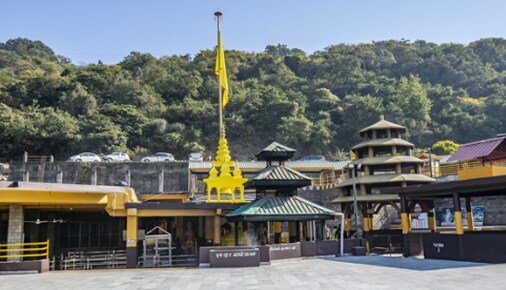
The Baglamukhi temple’s structure is significantly influenced by the Nagara style, characterized by its beehive-shaped tower, known as the shikhara. The shikhara, tapering upwards, intricately adorned with carvings of deities and mythological motifs, captures the viewer’s attention with its meticulous detail. This central spire stands majestically, symbolizing the cosmic mountain, Mount Meru.
Surrounding the main sanctum are smaller shrines and intricate mandapas (pillared halls) that showcase the fine craftsmanship of stonemasons. The use of locally sourced granite and sandstone in the construction not only adds to the temple’s robust visual appeal but also ensures its durability against the test of time and the elements.
A noteworthy feature is the temple’s Garbhagriha (sanctum sanctorum), which houses the idol of Goddess Baglamukhi. This sacred chamber, usually dimly lit, is resplendent with carved stone pillars and walls, featuring depictions of various forms of Goddess Shakti. The sanctum’s floor, often polished to a gleaming finish, adds a touch of tranquility and reverence to the space.
One cannot overlook the temple’s intricate doorways and gateways, traditionally called toranas, which are adorned with detailed carvings and ornamental designs. These gateways not only serve as entrances but also symbolize the transition from the material to the spiritual world.
The Baglamukhi Temple is further distinguished by its elaborate carvings of floral patterns, mythological scenes, and celestial beings, which are visible throughout the complex. These decorations serve not only as aesthetic enhancements but also convey tales from Hindu mythology, creating a tapestry of cultural and religious significance.
Local Folklore and Goddess Baglamukhi Significane
Goddess Baglamukhi, revered at the Baglamukhi Temple in Bankhandi, Kangra, holds a profound place in Hindu spirituality. Also known as “Pitambara Maa,” her portrayal is often depicted with a golden complexion, dressed in yellow attire, which she is believed to embody strength and the power to control adverse energies. Her iconography typically shows her holding a cudgel in one hand, symbolizing the power to stun and paralyze her adversaries, and a tongue of an asura, signifying her ability to silence enemies and negate their influence.
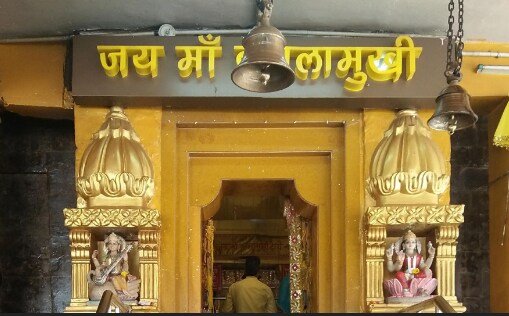
In the expansive pantheon of Hindu deities, Baglamukhi is venerated as one of the ten Mahavidyas, a group of ten Tantric goddesses known for their transformational and protective powers. Believers perceive her as a form of Shakti — the divine feminine power that is both nurturing and formidable. Goddess Baglamukhi’s sayuja (identity) with Shakti makes her a supreme force against evil, during critical moments of life, including legal battles, competitive exams, and disputes. Devotees seek her blessings to gain victory over negativity, overcoming enemies, and achieving prosperous outcomes.
The divine significance of Goddess Baglamukhi extends to various spiritual practices and rituals, emphasizing her role in tantra and mantra sadhanas (practices). Mantras dedicated to her are intensely recited by practitioners, aiming to harness her powers for protection, stability, and the triumph of truth over deceit. Her worship, particularly in the pristine setting of the Baglamukhi Temple in Kangra, becomes a profound spiritual experience, drawing thousands of seekers yearning for divine intervention in their worldly affairs.
Devotees’ deep faith in Goddess Baglamukhi embodies the enduring essence of devotion, where her blessings are sought to lead a life of harmony, free from obstacles and adversarial forces. Her significance within the broader context of Hindu worship reinforces the belief in divine protection and the ultimate victory of righteousness.
Rituals and Festivals of Baglamukhi Temple
The Baglamukhi Temple in Bankhandi, Kangra, is not just a beacon of spiritual energy but also a hub of vibrant rituals and festivals that reflect the deep-rooted cultural ethos of the region. Daily worship practices at the temple follow a meticulous routine, starting with the early morning aarti, which marks the beginning of the day with devotional hymns and offerings to Goddess Baglamukhi. The priests, draped in traditional attire, perform various ceremonies, including the lighting of lamps, flower offerings, and chanting of sacred mantras, creating a serene ambiance conducive to spiritual connection.

Particular significance is attributed to special ceremonies such as the ‘Chandi Path’ and ‘Hawan’. Chandi Path involves the recitation of the sacred texts, believed to invoke the divine energy of Goddess Baglamukhi, while Hawan entails ritualistic fire offerings intended to purify the environment and the worshippers’ minds. These ceremonies, often conducted by learned priests, attract a large number of devotees seeking divine intervention for overcoming obstacles in their lives. The sound of bells, the aroma of incense, and the divine chants collectively elevate the spiritual experience for everyone present.
The annual festival of Navratri holds special importance at Baglamukhi Temple. This nine-day festival, dedicated to the divine feminine, sees the temple adorned with elaborate decorations and illuminated with lights. Devotees from across the country gather to participate in elaborate rituals, culminating in a grand procession on the final day. Unique customs such as the offering of yellow garments and turmeric, which are considered auspicious by the followers of Goddess Baglamukhi, are a highlight of the celebrations.
Apart from Navratri, other significant events include ‘Guru Purnima’ and ‘Durga Ashtami’. These occasions are marked by grand ceremonies and an influx of pilgrims eager to seek blessings. The participation of devotees, clad in exuberant traditional outfits, chanting in unison, and engaging in communal feasts, encapsulates the sense of unity and devotion that the temple fosters. Such congregation not only bolsters communal ties but also underscores the spiritual solidarity among the devotees.
Best Time to Reach Baglamkuhi Temple
The best time to visit the Baglamukhi Temple in Bankhandi is during the spring season, from March to May. The weather is pleasant and comfortable during this time, making it ideal for exploring the temple and the surrounding area.
Here are some additional reasons why spring is the best time to visit:
- Pleasant weather: The temperature is mild and comfortable, making it enjoyable to walk around the temple complex.
- Fewer crowds: The temple is less crowded during the spring season, allowing you to enjoy a more peaceful experience.
- Beautiful scenery: The surrounding hills and forests are in full bloom during the spring, creating a picturesque backdrop for your visit.
However, if you prefer a less crowded experience, you can also consider visiting during the monsoon season (July to September) or the winter season (October to February).
How to Reach
The Baglamukhi Temple in Bankhandi, Kangra, Himachal Pradesh, is approximately 26 kilometers from Kangra on the Hoshiarpur road. Here are the ways you can reach it:
By Road:
- Car: The most convenient option is to drive to the temple. You can use GPS navigation or follow the directions provided by local people.
- Bus: There are regular buses from Kangra to Bankhandi. You can also take a bus to Dehra, which is closer to the temple, and then take a local taxi or auto-rickshaw.
By Air:
- The nearest airport is Kangra Airport, which is approximately 35 kilometers from the temple. From the airport, you can take a taxi or bus to Bankhandi.
By Train:
- The nearest railway station is Kangra Railway Station, which is approximately 20 kilometers from the temple. From the station, you can take a taxi or bus to Bankhandi.
Additional Tips:
- The Baglamukhi temple is open from 5:00 AM to 8:00 PM.
- It is advisable to carry your own food and water, as there may not be many options available near the temple.
- The temple is located in a hilly area, so it is recommended to wear comfortable shoes.
Best Places to Visit Nearby Baglamukhi Temple
Kangra Fort: An Ancient Marvel
Nestled in the serene environs of Kangra Valley, Kangra Fort stands as a testament to the architectural prowess and historical significance of ancient India. Situated near the revered Baglamukhi Temple in Bankhandi, Kangra Fort is one of the oldest and largest forts in India, with its origins tracing back to the Trigarta Kingdom. Historically, the fort has been under the control of several dynasties, including the Katoch Dynasty, which is considered one of the oldest surviving royal lineages in the world.
Masroor Rock Cut Temples: A Hidden Gem
Nestled in the serene landscapes of Kangra, the Masroor Rock Cut Temples present an extraordinary blend of historical grandeur and intricate craftsmanship. These monolithic rock-cut temples date back to the 8th century, standing as a testament to the architectural prowess of ancient Indian craftsmen. Carved entirely out of a single rock, this ensemble comprises 15 richly ornamented shrines, each exhibiting distinct elements of North Indian Nagara style architecture.
Baijnath Temple: A Testament to Ancient Architecture
The Baijnath Temple, an enduring emblem of ancient architecture, stands as a significant religious site dedicated to Lord Shiva. Located in the serene town of Baijnath in the Kangra Valley of Himachal Pradesh, this temple’s origins can be traced back to 1204 AD. Constructed by the local merchants Ahuka and Manyuka, the temple has withstood the sands of time, maintaining its original splendor and attracting devotees and tourists alike.
Andretta Artist Village: A Cultural Hub
Andretta Artist Village, nestled in the picturesque Kangra Valley, is renowned for its rich artistic and cultural heritage. The village was founded in the 1920s by Norah Richards, an Irish theatre artist, who envisioned a sanctuary for creative minds. Her initiative attracted artists, writers, and theatre enthusiasts, transforming the village into a vibrant hub for artistic endeavors.
Trekking and Adventure Activities in Dhauladhar Range
The Dhauladhar Range, a prominent feature of the Himalayas in Himachal Pradesh, presents itself as a haven for trekking and adventure seekers near Kangra. This mountainous landscape, known for its rugged beauty and diverse ecosystem, offers a multitude of thrilling activities that draw in adventurers from across the globe.
A notable trekking route in the Dhauladhar Range is the Triund Trek, which is highly popular due to its relatively moderate difficulty and breathtaking vistas. The trek starts from McLeod Ganj or Dharamkot and takes around four to six hours to complete, depending on the starting point. As trekkers ascend, they traverse through dense forests of oak and rhododendron, eventually reaching the grassy meadows of Triund hill. From here, the panoramic views of the snow-capped peaks and the Kangra Valley below make the effort worthwhile.
Palampur: The Tea Capital of North India
Palampur, often recognized as the ‘Tea Capital of North India,’ lies nestled amidst the verdant hills of Himachal Pradesh, offering a tranquil retreat characterized by its scenic allure and a flourishing tea industry. The town’s lush tea gardens extend across its landscape, presenting visitors with a mesmerizing sight of neatly aligned tea plants that stretch endlessly, a testament to the region’s long-standing tea cultivation traditions.
What is Baglamukhi Temple Kangra famous for?
It is most famous and powerful Shakti Peetha of Ma Baglamukhi. The pujas performed at this temple are extremely powerful for victory in legal cases. Baglamukhi is worshipped for power, victory, protection for cuts, scars, operations and accidents and dominance over enemies.
Which part of Sati fell in Baglamukhi Temple?
The left breast of Sati fell at this spot, thus making it a Shakti Peetha.
Is Baglamukhi a shakti peeth?
Considered to be among one of the 52 hallowed Shakti Peeths in India and Nepal, it is a highly revered place of worship. It is said that any “Mannat” that one makes over here gets fulfilled.
What is the story of Baglamukhi Temple?
Goddess Baglamukhi calmed the storm, restoring peace in the universe. It is furthermore said that The Baglamukhi Temple was built in the Dwaparyug by the Pandavas during ‘Agyatvas’. The Pandavas built the Temple in one night. Bhima and Arjuna worshipped Goddess Baglamukhi to get blessings and power from The Deity
What are the benefits of Baglamukhi Temple?
Ensures victory over enemies and renders their ill intention futile.
Success in lawsuits, quarrels and competitions.
Removes evil eye and effects of black magic.
Protects from mishaps, diseases and negative energies.
Helps remove debts and brings prosperity and stability
Why do people worship Baglamukhi?
Baglamukhi or Bagala is an important deity among the ten Mahavidyas worshipped with great devotion in Hinduism. The ultimate benefit of worshipping Baglamukhi clears the illusions and confusions of the devotees and gives them a clear path to proceed in life.
When should I visit Baglamukhi Temple?
Thursdays are auspicious and best day to visit as it is maa baglamukhi’s day. We saw lot of devotees offering yagna and prayers. the yagna costs around 2500 to 3000 and includes temple darshan , pooja material,dakshina of poojari,and offerings in the yagna.
